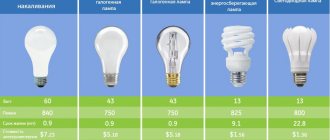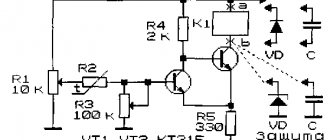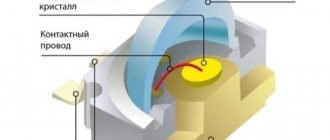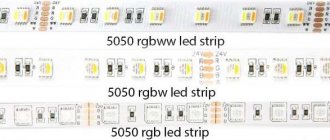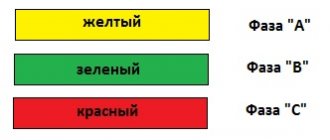In this article we will talk about color temperature and look at the table of LED lamp parameters. You can find this parameter on many lamps and you need to pay attention to it.
Color temperature indicates the wavelength that can be emitted by an element that illuminates a room. It is measured in Kelvin.
Our eyes can see radiation in the range of 800-25000 K, and each of them is perceived differently. Next we will talk about this and what kind of lighting is better perceived by our visual organs. We will also consider what light temperature is best for a particular room.
Concept of color temperature
Color temperature is the most important characteristic of LED electric lighting products. It determines how comfortable you will feel in the interior illuminated by LED lamps, strips or lamps.
New cars are equipped with LED lamps, houses, business premises and outdoor advertising stands are illuminated. They are used in spotlights, street and office lamps, as well as in many other human inventions.
The concept of color temperature of LED lamps does not even imply the amount of heat they give off, but has a completely different meaning. This is the visual effect of the perception of a light source by the human eye. As the color spectrum of light approaches the sun (yellow), the “warmth” of each lamp is determined.
You can also make an association with a candle flame, and you will immediately understand how this phenomenon is described. On the contrary, a bluish tint of light is associated with a cloudy sky and snowy night glow. This light evokes cold, pale images in us. But there is a definite scientific explanation for everything.
When a piece of metal is heated, it develops a characteristic glow. First the color range is in red tones. As the temperature rises, the color spectrum gradually begins to shift towards yellow, white, bright blue and violet.
Conventionally, we have the following table of color temperature of LED lamps:
Each color of metal glow has its own temperature range, which makes it possible to describe the phenomenon using known physical quantities. This helps to characterize color temperature not as a randomly taken value, but as a certain heating period until the required spectrum color is obtained.
The color spectrum of LED crystals is somewhat different. It is different from the possible colors of metal glow due to a different method of its origin. But the general idea remains the same: to obtain the selected shade you will need a certain color temperature.
It is worth noting that this indicator is in no way related to the amount of heat generated by the lighting fixture.
Color temperature is measured in degrees Kelvin (K).
- According to European standards, all light sources are divided into three groups based on color:
- warm white (Tc = below 3500 K)
- neutral white or daylight (Tc = 3500-5300 K)
- cool white (TC = above 5300 K)
The color temperature of a conventional incandescent lamp is approximately 2800 K, so the warm-white light of LED lamps is most familiar to the eye (from 2700 to 3500 K).
For most types of work and premises, “neutral” light sources (Tcv = 4000-4500 K) are recommended. If we talk about the influence of color temperature on a person, then warm light relaxes and creates an atmosphere of comfort, and cooler tones help the body concentrate and set the mood for work.
Once again, I want to note that you should not confuse the color temperature and the physical temperature (amount of heat) that your lamp emits - these are different indicators.
By combining lighting sources with different temperatures within one room, you can change the color perception of objects in the interior. But don't get carried away! It is important to ensure the harmony of colors, otherwise you may end up with a “color disco” that will irritate your eyes. And an unsuccessful decision will show the taste of the apartment owner is not from the best side.
- The red color can be softened by a warm orange tint of light (2500-3000 K).
- The orange color (intense) is transformed into a soft and pastel color with the help of a warm yellowish tint (3000-4000 K).
- The yellow color will become gray and inexpressive if you use lamps with a bluish tint (5000-6500 K).
- The green color can be softened to light green using warm orange light or given a sea green hue using bright bluish light.
- The blue color can be most adequately conveyed by light sources of a neutral white hue.
- The violet color will turn into red under a yellowish tint of lighting, so it is illuminated with high color temperatures.
By making a mistake when choosing a lamp of a certain color temperature, you can significantly change the color perception of the interior. Our eyes distinguish about 10 million different shades, so lighting directly determines how we perceive the color of interior items.
What is measured in Kelvin
This concept relates to physics. Scientists have long established that each color has its own “temperature,” which is measured in Kelvin (K). This parameter is indicated on lamp packaging. Absolutely black color (black body) has zero color temperature (0 Kelvin).
- The dark red hue will take on a completely black body if it is heated to a temperature of 800 K (which corresponds to 527 ° C).
- Bright red color corresponds to a temperature of 1300 K (or 1027 ° C). In real life, this phenomenon can be observed when heating some metals.
- Orange color – 2000 K (or 1727°C). This light comes from a candle or hot coals.
- Yellow color – 2500 K (or 2227°C). It can be seen at sunrise.
- White color – 5500 K (or 5227°C). It matches the color of the sun at noon.
- Blue color – 9000 K (or 8727°C). This is the color of a thermonuclear reaction, which is almost impossible to see in life.
As we see, in fact, those colors that are considered “cold” in everyday life (white, blue) are obtained from the hottest bodies. It is worth noting that the lamps do not heat up to such temperatures, and the value in Kelvin is a comparative conditional indicator.
How does it work in everyday life?
This temperature principle works in the production of light sources and their selection for use in interiors. All lamps have a certain temperature.
When choosing light sources, you need to know what temperature corresponds to a particular shade. For some areas in the interior, designers recommend using lamps of the appropriate color temperature.
| Color temperature, K | Hue | Application |
| 2500–3000 | Warm orange | Cozy evening atmosphere in the bedroom, living room. Dining table lighting. Floor lamps, sconces, bedside lamps. |
| 3000–4000 | Warm yellowish | Comfortable and relaxing light for living rooms. Most often, this temperature is used in chandelier lamps and wall lamps. |
| 4000–5000 | Neutral white | Daylight for living rooms, kitchens, office workstations, reading corners. Suitable for ceiling and pendant lights. |
| 5000–6500 | Bluish | This color temperature is not used in the home. Most often used in jewelry stores and museums. |
For certain areas in a house or apartment, as well as for specific situations (for a living room - receiving guests, a romantic dinner, etc.), light sources with the most comfortable shade and appropriate color temperature are selected.
Blacker than black
Where does it all begin? Everything starts from scratch, including light radiation. Black color
is the absence
of light
at all.
From the point of view of color, black is 0 radiation intensity, 0 saturation, 0 hue (it simply does not exist), it is the complete absence of all colors at all. Why we see an object black is because it almost completely absorbs all the light falling on it. There is such a thing as an absolutely black body
. An absolute black body is an idealized object that absorbs all radiation incident on it and does not reflect anything. Of course, in reality this is unattainable and absolutely black bodies do not exist in nature. Even those objects that seem black to us are not actually completely black. But it is possible to make a model of an almost completely black body. The model is a cube with a hollow structure inside; a small hole is made in the cube through which light rays penetrate into the cube. The design is somewhat similar to a birdhouse. Look at Figure 1.
Figure 1 – Model of a completely black body.
Light entering through the hole will be completely absorbed after repeated reflections, and the outside of the hole will appear completely black. Even if we paint the cube black, the hole will be blacker than the black cube. This hole will be a completely black body
.
In the literal sense of the word, the hole is not a body, but only clearly demonstrates
to us an absolutely black body.
All objects emit heat (as long as their temperature is above absolute zero, which is -273.15 degrees Celsius), but no object is a perfect heat emitter. Some objects emit heat better, others worse, and all this depending on different environmental conditions. Therefore, a black body model is used. A completely black body is an ideal thermal emitter
.
We can even see the color of a blackbody if we heat it up, and the color we see
will depend on the
temperature to which
we
heat
the blackbody. We have come close to the concept of color temperature. Look at Figure 2.
Figure 2 - The color of an absolutely black body depending on the heating temperature.
a) There is an absolutely black body, we don’t see it at all. Temperature 0 Kelvin (-273.15 degrees Celsius) is absolute zero, the complete absence of any radiation. b) Turn on the “super-powerful flame” and begin to heat up our absolutely black body. The body temperature, through heating, increased to 273K. c) A little more time has passed and we already see a faint red glow of a completely black body. The temperature increased to 800K (527°C). d) The temperature rose to 1300K (1027°C), the body acquired a bright red color. You can see the same color glow when heating some metals. e) The body has heated up to 2000K (1727°C), which corresponds to an orange glow. Hot coals in a fire, some metals when heated, and a candle flame have the same color. f) The temperature is already 2500K (2227°C). The glow at this temperature becomes yellow. Touching such a body with your hands is extremely dangerous! g) White color – 5500K (5227°C), the same color of the glow of the Sun at noon. h) Blue color of the glow – 9000K (8727°C). In reality, it will be impossible to obtain such a temperature by heating with a flame. But such a temperature threshold is quite achievable in thermonuclear reactors, atomic explosions, and the temperature of stars in the universe can reach tens and hundreds of thousands of Kelvin. We can only see the same blue tint of light, for example, from LED lights, celestial bodies or other light sources. The color of the sky in clear weather is approximately the same color. Summarizing all of the above, we can give a clear definition of color temperature. Colorful temperature
is the temperature of a completely black body at which it emits radiation of the same color tone as the radiation in question. Simply put, 5000K is the color that a black body acquires when heated to 5000K. The color temperature of orange is 2000K, which means that a completely black body must be heated to a temperature of 2000K for it to acquire an orange glow. But the color of the glow of a hot body does not always correspond to its temperature. If the flame of a gas stove in the kitchen is blue-blue, this does not mean that the flame temperature is above 9000K (8727°C). Molten iron in its liquid state has an orange-yellow hue, which actually corresponds to its temperature, which is approximately 2000K (1727°C).
Color temperature scale
Today's domestic market offers a huge range of light sources based on LED crystals. They all operate in different temperature ranges.
Usually they are chosen depending on the location of the intended installation, because each such lamp creates its own, individual look. The same room can be significantly transformed by changing only the color of the lighting.
For optimal use of each LED light source, you should decide in advance which color is most convenient for you. The concept of color temperature is not specifically related to LED lamps, it cannot be tied to a specific source, it depends only on the spectral composition of the selected radiation.
Each lighting device has always had a color temperature, it’s just that when standard incandescent lamps were released, their glow was only “warm” yellow (the emission spectrum was standard).
With the advent of fluorescent and halogen lighting sources, white “cold” light came into use. LED lamps are characterized by an even wider range of colors, due to which the independent choice of optimal lighting has become more complicated, and all its shades began to be determined by the material from which the semiconductor was made.
Color rendering index of LED lamps
The color rendering index characterizes the ability to perceive color gradations. When the light temperature of LED lamps is below 3200 K, color perception is significantly reduced. Try pulling out a green or brown color from a box of colored pencils by candlelight. Believe me, the task will not be easy.
The color rendering index is very clearly regulated for automotive LED lamps, because if color rendering is poor, a situation may arise when the driver cannot distinguish between the road surface and the side of the road.
Light can change the brightness and saturation of colors in a room. This phenomenon is called metamerism.
Each lamp has a certain color rendering, which is indicated on the packaging by the Ra (or CRl) index. This source parameter is determined by its ability to accurately convey the colors of the illuminated object.
You will achieve the best results by using lamps with a color rendering index of 80 Ra and higher. This will allow all interior colors to look most natural.
| Characteristic | Coefficient | Examples of lamps |
| Reference | 99–100 | Incandescent lamps, halogen lamps |
| Very good | More than 90 | Fluorescent lamps with a five-component phosphor, MGL lamps (metal halide), modern LED lamps |
| Very good | 80–89 | Fluorescent lamps with three-component phosphor, LED lamps |
| good | 70–79 | Fluorescent lamps LBC, LDC, LED lamps |
| good | 60–69 | Fluorescent lamps LD, LB, LED lamps |
| Mediocre | 40–59 | DRL lamps (mercury), NLVD with improved color rendering |
| Bad | Less than 39 | HPS lamps (sodium) |
Different types of lamps, while having the same color temperature, can render colors differently. The color rendering index determines the degree of deviation of the color of interior items from its real color when illuminated by a particular lamp.
The role of Tc and other parameters in the technical standardization of lighting
When designing buildings and structures, engineers use data on standardization of lighting parameters from SNiP 23-05-95. The document establishes selection rules for the following characteristics (in descending order of importance):
- illumination (Ev), lux = lm/m2 - the main parameter in the list;
- color temperature (Tc), K or wavelength (λm), nm;
- color rendering index (CI, CRI or Ra), %;
- Pulsation coefficient, (Kp), %;
- highest permissible brightness (Lmax), cd/m2;
- Uniformity of illumination;
- Specific installed power (Nsp), W/m2.
Determining the functional sufficiency of lighting, the illumination of a point in space depends on the power and efficiency of the IC, the geometry of the room and the heights of the luminaires and the control surface. Illumination has a nonlinear relationship with Tc.
With low Ev, people see red worse, blue better. The opposite statement is also true: the higher Ev, the better the shades of red are distinguished and the worse the shades of blue. This effect is reflected in the Kruithof visual comfort graph.
Rice. 9 Kruithof optimization field
Thanks to the Kruithof curves, we are able to optimize lighting with the same degree of comfort using different types of lamps.
The color rendering index characterizes the ability of the light source to convey the natural tones of the illuminated object in comparison with the conventional ideal - the reflected midday sun (5500 K). The highest IRC indices are demonstrated by incandescent lamps (up to 98%), as well as metal halide and LED ICs (up to 95%).
The remaining normalization parameters are not directly related to color temperature.
Lighting of certain types of objects and systems can be standardized by industry technical standards. For example, for highways in the Russian Federation, ODM 218.8.006-2016 applies.
Color Temperature Marking
On the packaging of each lighting lamp, manufacturers indicate its technical characteristics. Among all other characteristics, such as power, voltage, network frequency, the color temperature of LED lamps must be indicated (this applies not only to LED lamps).
You should definitely pay attention to this main factor before purchasing a lamp.
By the way, this characteristic is displayed not only on the packaging, but also on the lamp itself. Here is one example, an LED lamp with a power of 7 W and a temperature of 4000 K. It is installed in my home, in the kitchen, and shines with pleasant daylight.
And here is another example of the designation on an LED spotlight for plasterboard ceilings, temperature 2800 Kelvin. Lamps with this color temperature shine with a warm light similar to an incandescent lamp and were installed in the bedroom of one of the objects.
Having trouble choosing LED lights?
We will prepare a full calculation of the cost, necessary equipment and 3D visualization for lighting your facility. It’s FREE - even before purchasing and concluding a contract, you can find out: “How many and what kind of lamps are suitable?”, “How much will it cost?”, “What will it look like?”
and even “How long will the counter wind up?” More about this
Light temperature in functional lighting
There are 2 main types of functional lighting - general and local. Depending on the purpose of the room/zone/object/, it is recommended to use equipment with Tc values in the range of 2400… 7000 K.
| Recommended color temperature of artificial lighting, K | ||
| Space | General knowledge | Local development |
| Living rooms | 2800… 4200 | 2400… 4200 |
| Bedrooms | 2400… 3200 | 2400… 3500 |
| Children's | 2800… 3200 | 2800… 3500 |
| Common areas | 3200… 5500 | 3500… 5500 |
| Kitchens in apartments | 2800… 3200 | 3500… 5500 |
| Classes of educational institutions | 3200… 4500 | |
| Offices | 4000… 6500 | 4000… 6500 |
| Recreation areas | 2200… 3200 | 2200… 3000 |
| Warehouses | 3200… 5500 | 3200… 7000 |
| Workshops | 4000… 7000 | 4000… 7000 |
| Printing houses | 6500 | 6500 |
| Advertising agencies | 4000… 5500 | 4000… 6500 |
| Highways | 3500… 5000 | |
| Parks, boulevards | 5000… 7000 | 5000… 7000 |
The color temperature of LED lamps can correspond to any range indicated in the table. Therefore, the actual choice between LED and another type of IC will depend not on Tc, but on other technical or economic parameters.
Rice. 7. Edison lamps are one of the few areas where LEDs are still losing
Light temperature and design challenges
By selecting lamps of a certain spectral characteristic, the designer can:
- emphasize the advantages and soften the shortcomings of the room - for example, poisonous green walls will become delicately light green if you fill them with an orange (2200 K) stream; vulgar flashy red will be softened by backlighting with ordinary yellow (3200 K); the room will increase in size if you emphasize the verticals and horizontals with blue (7000 K) soffits;
- create a special emotional atmosphere - Edison lamps (2000 K) will help emphasize the intimacy and comfort of a bar, cafe, lounge area; cold bluish lighting will add romanticism and pathos to the hall of ancient sculpture in the museum; UV lamps (7000… 9000 K) in a nightclub will emphasize the graphic nature of the dancers’ poses and give the figures an alien mystique;
- effectively convey the color characteristics of the product on the store window by placing - meat - under IC 2800... 3500 K; fish - under metal halide or LED lamps with a color temperature of 4000... 6500 K; jewelry - under lighting 5500... 6500 K; furniture - under warm lamps, and curtains and textiles - under cool white ones.
Tc special ICs
To perform certain technological tasks, it is possible to use ICs with a narrow range of light waves. Water disinfection installations and air disinfection lamps contain bactericidal lamps with a light temperature of 12,000 K or more. Sources of 10,000...15,000 K are also used for curing composite adhesives and structural composites in engineering and dentistry.
Rice. 8. Disinfection of subway cars with bactericidal UV lamps
Sodium, metal halide and narrow spectrum LED sources are used in crop production. The required values of their light temperature depend on the stage of plant growth.
Relationship between color temperature and lighting
A clear knowledge of the tabular values of this characteristic helps to understand what color will be discussed further. Each of us has a different color perception, so only a few can visually determine the coldness or warmth of the light flux.
The average indicators of a group of products operating in a given spectrum are taken as a basis, and when making the final selection of LED lamps, the specific conditions of their operation (installation location, illuminated space, purpose, etc.) are taken into account.
- Today, all lighting sources, depending on their luminescence range, are classified into three main groups:
- warm white light - work in the temperature range from 2700 K to 3200K. The spectrum of warm white light they emit is very similar to the glow of a conventional incandescent lamp. Lamps with this color temperature are recommended for use in residential areas.
- daylight white light (normal white) – in the range from 3500 K to 5000 K. Their glow is visually associated with morning sunlight. This is a neutral range luminous flux that can be used in apartment technical rooms (hallway, bathroom, toilet), offices, classrooms, production workshops, and so on.
- cool white light (day white) – in the range from 5000 K to 7000 K. Reminiscent of bright daylight. They illuminate hospital buildings, technical laboratories, parks, alleys, parking lots, billboards, etc.
It would seem, why do we need LEDs of warm and cold colors if they are not able to provide normal perception conditions.
One of the main areas of application of LEDs with low color temperature (2400-3000 K) is lighting in a “noisy” optical environment. Simply put, lighting in poor visibility conditions.
Let's take a car headlight. In heavy fog, white light, due to its short wavelength, is reflected from water spray, which significantly limits the visibility range. Yellow light has a wavelength several times longer; it does not reflect from small objects, but bends around them. That's why fog lights in cars are made yellow.
At the same time, short waves propagate further without attenuation. As an analogy, consider radio waves and hard short-wave X-rays.
Even a thin sheet of metal blocks radio waves, and thick lead is used to protect against x-rays. Cool white light is used in long-distance warning systems, floodlights, signal and search lights.
Psychology of lighting perception
As Tc increases, the emission spectrum changes from red to orange, yellow, green, blue, blue, and finally violet. This order corresponds to the order of colors on the spectral circle and the increase in photon energy from the infrared to ultraviolet parts of the spectrum.
Rice. 3. Itten's spectral circle
Paradoxes within us
However, people associate the connection between color and energy in exactly the opposite way: we perceive red, orange, yellow tones as “warm”, and turquoise, blue, indigo, and violet as “cold”. After all, the sun and flame are the warmth familiar to earthlings, and the blueness of the sky or a piece of ice is the same familiar freshness or coolness.
Another important point of difference between physics and psychology concerns the color white. On the Tc scale, the white point is located at around 5500 K, which corresponds to reflected sunlight at noon. But the sun emits the entire spectrum. 5500 K is only the average resultant, and white seems to us to be a tone corresponding to spectral balance. The decomposition of white into individual components is clearly demonstrated by the rainbow and, for example, the iconic CD cover for the album “The Dark Side Of The Moon” by Pink Floyd.
Rice. 4. The decomposition of white light into a spectrum on the cover of the album “The Dark Side Of The Moon” by Pink Floyd.
Right now, when you look at a monitor or smartphone display, every white pixel is the result of the simultaneous glow of 3 of its components (red, green, blue).
Any lamp with a color temperature other than 5500 K imparts a chromatic tint to visible surfaces. More noticeable - for values outside the range of the so-called. neutral white light (4000... 6000 K). However, due to the fact that we are accustomed to perceive the yellowish light of flames and incandescent light bulbs as “ordinary, natural,” even the glow of fluorescent and LED light sources 4000... 5000 K seems cold to us. Such domestic products are labeled as “cool white” sources, and indications of “warm white” are found at Tc = 2500... 3000 K.
Rice. 5. Warm, neutral and cool white light
Associations and emotions
Light and color have a powerful effect on the formation of the psychophysiological status of the human body. Clinical observations allow us to give the following characteristics to flowers:
- red - stimulating, activates all body functions, increases muscle tension for a short time, increases blood pressure, accelerates the breathing rhythm;
- yellow - tonic, increases muscle activity, stimulates the activity of the central nervous system;
- green, blue - calm, relieve stress, help to concentrate during long-term intellectual work and high-precision physical work. However, an excess of cold tones (including purple tones - lilac, violet) can contribute to the growth of depressive moods.
6. Cold lighting of the meeting space in the office It would seem that a wall painted red should be perceived as “warm”. But it is enough to illuminate it with a source with radiation of 6400 K for it to acquire a cold purple hue. Of course, the list contains only stereotypical associations. They are highly dependent on cultural preferences, and children's favorite colors differ from those of "adults." However, the subconscious influence of light temperature on the psyche does not depend on age and personality characteristics.
Which lamps to choose for the office
The regulatory document SP 52.13330.2011 “Natural and artificial lighting” recommends the use of various radiation sources depending on their type, power, design and characteristics of the luminous flux.
Residential premises are required to be equipped with small and low-temperature “warm” lighting devices, and in non-residential buildings larger lamps of normal “white” light must be installed.
It has been proven that white lighting is optimal for the work process, since the part of the blue spectrum it contains has a beneficial effect on a person, helps him concentrate, speeds up the reaction and work processes of the body.
It is good to choose radiation sources from 3500 K to 5600 K, with white or neutral light, with a slightly bluish tint. Such lighting will make it possible to increase performance to the maximum level.
Both fluorescent and LED lamps are suitable, although the latter will provide significant savings in energy resources.
On the contrary, it would be a big mistake to install cold white light lamps in such a place with a range close to 6500 K. This will lead to rapid fatigue of workers, complaints of headaches and a sharp decrease in performance.
In the workplace, the color temperature should be as close as possible to the color of natural light.
If with white light and prolonged human work we take its production as 100%, then with yellow light it will be only 93%, with green 92%, with blue 78%, with red and orange 76%. Those. in the workplace, daylight will be more useful (approximately 4000-4500 K).
Color perception
Each individual's color perception has its own characteristics. The perception of color is the effect of refraction of light waves received by the optic nerve and processed by the brain's visual center. Each person has their own perception of shades. The older a person gets, the more his color perception becomes distorted. The mental characteristics of an individual also affect his color perception.
The perception of a particular color can be distorted by solar radiation. The warmth of light is also characterized by individual perception and depends on the characteristics of the body and the state of the person at the time of perception.
Which lamps are suitable for home
White light is not recommended in apartments and private houses. It is not necessary to place the same lamps everywhere; it is better to use individual recommendations for lighting equipment in such rooms. Lamps with white neutral light are well suited for lighting the kitchen, bathroom, and will fit into the interior of the hallway. Their temperature can vary from 4000 K to 5000 K.
But for the bedroom, nursery and rooms where you relax, it is preferable to use warm tones of the light spectrum. The best solution here would be warm white light closer to 2700 to 3200 K. It will relieve daytime tension, create comfort and allow you to relax.
It is convenient and effective to use normal white light in the reading area and work corner, as well as to illuminate mirrors in front of which makeup is applied. This way you will achieve maximum color contrast and convenience for the actions performed.
It is better to equip a child’s desk with a lamp with a temperature of 3200-3500 K. It will not create unnecessary eye fatigue, and proximity to the white spectrum will help to get ready and tune in to work. For all LED lamps, their operating temperature is indicated on the packaging.
While our eyes have become accustomed to the soft white color temperature of incandescent bulbs over the years, that doesn't mean they're necessarily the best option for lighting your entire home.
For example, because of their warm color temperature, these soft white lights often draw warm colors from the room (red, orange-colored objects), changing the contrasts throughout the space. Here are some tips on how to most effectively light different rooms in your home:
- Warm white light (2700-3200 K)
Warm light is preferable for recreational areas, that is, places intended for relaxation. Such lamps are installed in bedrooms and living rooms. In the living room it is better to combine neutral and warm light.
If there is insufficient natural light, we turn on neutral or both, and in the evening or when watching TV, turn on warm. For the bedroom, you should definitely opt for warm light lamps.
- Neutral white light (3200-4500 K)
It is preferable to use such lamps in rooms intended for visual work. This radiation spectrum does not tire the eyes and provides the best color perception.
- Cool white light (over 4500K)
As already mentioned, cool white light has a stimulating effect on our brain. In everyday life, it is used in situations where periodic concentration of attention is desirable, for example, examination rooms, operating rooms.
LED lamps with cool white light placed in the bathroom will help you get into working tone faster in the morning.
Color temperature and our emotions
The temperature of light can directly affect a person’s psychological state. Warm orange and yellowish shades are best used for the morning, as they promote a gentle awakening, put you in a positive mood and stimulate activity.
These shades are also good to use in the evening because of their calming effect.
Light sources with neutral white are ideal for rooms where they spend a lot of time and work for a long time. Such shades are most consistent with midday sunlight, so the body perceives such lighting as a signal for vigorous activity.
Lamps with a high color temperature cannot be used for a long time, as they have an extremely stimulating effect on the human psyche. When used short term, this light stimulates the body. And in the long term, the opposite effect is possible - inhibition, depression.
At a low level of illumination (little light), a person feels better in “warm light” (Tcv = 3000 K), and if the illumination is high (>700 lux), then discomfort and pain in the eyes will appear. And vice versa: Tcv = 5000 K - comfortable from 700 lux to 2500 lux, but at illumination less than 150 lux the light will be perceived as alarming (moonlight).
The temperature of the light affects the psychological state of a person, creates a certain atmosphere in the room, activates the body’s work or, on the contrary, relaxes.
The use of lamps with one or another central heating.
For indoor lighting, SP 52.13330.2016 (SNiP 23-05-95) was developed. Warm light is recommended for living rooms, daylight (3000-4000 K) for work rooms, and cool light (5000-6000 K) for rooms with high color requirements. The document advises, if there are a large number of green and blue objects in a space, to choose lamps with a central heating value of more than 4000 Kelvin. And with an abundance of red and yellow objects - less than 3500 K.
Designers use light from lamps to create interiors.
Warm light from lamps
Warm light.
CT in the range from 2700 to 3000 K. Reminiscent of incandescent light, soft sunlight. The shade is not boring or irritating. Creates a warm, cozy atmosphere. Suitable for residential premises, libraries, restaurants, cafes, etc. In apartments, ideal for bedrooms, spot lighting.
Cool color of lamps.
Cold lighting.
CT over 4500 K. Well suited for workspaces, training rooms, offices, workshops. Cool white will create a clean, productive atmosphere. In an apartment, it is more appropriate to use it to illuminate the work area or bathroom. Not suitable for small spaces - the light will be too bright and disturbing.
Neutral color of light sources.
Neutral light.
CT in the range of 3200-4500 K. The light is suitable for different rooms: living rooms, corridors, kitchens, etc. Indispensable as illumination for places where people dress and preen themselves. Also great for classrooms and offices as the neutral light is easy on the eyes.
When planning your home's lighting design, remember that warm tones highlight the warm colors in the room. Red, yellow and orange look best in warm lighting. Blue and green will appear faded. Cool shades will emphasize green and blue tones, while warm colors will be somewhat distorted and muted.
What is color
No matter how strange it may sound, light has its own color temperature! Your apartment, house, office or grocery supermarket across the street has lamps and lighting devices.
And your perception of objects and even your mood depend on what color temperature they have. Let's understand these digital values, how many Kelvins are there for what kind of glow.
- 2700 K – popularly sounds like a warm glow or warm white.
- 4000-4200 K is naturally white, although many consider it a cool white or cool glow, although this temperature is closest to the morning sun and lunchtime sun.
- 5500-6000 K – bright white or close to daylight.
Different types of lamps are used in the interior and exterior, based on the tasks, conditions and personal preferences of the person.
In classic interior design, warm or warm white light (2700 K) is mainly used. LED lamps are ideal for these needs. In the color temperature column, check the “warm glow” box.
For a rapidly developing world, a glow temperature of 4000-4200 K is increasingly suitable, so naturally white light is used in Hi-tech design interiors.
For offices, conference rooms, laboratories and other high-precision work performed indoors, use bright white from 6000 K and above.
Warm light how many Kelvins
Warm orange: 2500–3000 Kelvin - will help create a cozy evening atmosphere in the bedroom and living room. Used in floor lamps, sconces, bedside lamps, and for lighting the dining table. Warm yellowish: 3000–4000 Kelvin – relaxing and comfortable light for living rooms. Typically used in wall and ceiling lamps.
Cold white light how many Kelvins
Cool white - color temperature above 5300 K. If daylight is more appropriate in the workplace (approximately 4000-4500 K), then cooler white light is useful for reading (but only up to 6500 K).
2700 Kelvin what light
The color temperature of a conventional incandescent lamp is approximately 2800 Kelvin, so the warm-white light of LED lamps is most familiar to the eye (from 2700 to 3500 K).
3000 Kelvin what color
The color temperature of yellow is approximately 3000 K - this is a 200 W incandescent halogen lamp.
Color temperature 4000 K – what color is it
4000-4200 K is naturally white, although many consider it a cool white or cool glow, although this temperature is closest to the morning sun and lunchtime sun.
4300 Kelvin color
4300-4500 K – morning sun and lunchtime sun. If we talk about cars, standard xenon, which is installed directly at the factory, has a glow color of 4300 Kelvin. When replacing car lamps in order to maximize the best visibility, experts advise installing xenon with a color of 4300 K.
6000 Kelvin what light
The color of the radiation at 6000 K becomes bluish. This is how a fluorescent lamp with a daylight color of 6000 K shines.
6500 Kelvin what light
6500K is a standard daytime white light source, close to midday sunlight. For the working kitchen area, it is recommended to use cold light bulbs (above 6500 K), such light will invigorate.
Light colors
It is not difficult to identify a cold object from which no radiation is emitted. The main parameters of light reflection from such an object are indicators such as wavelength and frequency. Another situation occurs with a heated body emitting light. The warmth of light will directly depend on the type of radiation. This can be seen in the example of a tungsten filament in a simple incandescent lamp. The sequence of actions is as follows:
- The light turns on and electricity flows to the terminals.
- There is a gradual decrease in the level of resistance.
- A black body emits red light.
According to accepted standards, there are 3 types of light colors:
- warm white light;
- neutral (natural daytime);
- cool white light.
Which light is better: warm or cool?
Cold and warm light lamps
Light is usually divided into warm and cold. Warm light is best for the evening, while during the daytime cool light is most natural. Playing an important role in the formation of human circadian rhythms, warm light helps us relax, forget about the worries of the day and prepare for sleep.
Cold weather, on the contrary, keeps us in good shape, makes us more alert and energetic. But both cold and warm light can disrupt our internal clocks, catching us at the wrong time.
The color of light is expressed in color temperature (measured in Kelvin), equal to the temperature of a black body at which it emits radiation of the same color. You may be confused that warm light corresponds to a low temperature, and cold light corresponds to a higher temperature, but, unfortunately, this is exactly the case.
Thus, light with a color temperature of 2700-3000 K is called warm, has a yellowish tint and is typical of incandescent lamps. As their name suggests, they glow due to a hot tungsten filament, the actual temperature of which is directly related to the temperature of the color.
Fluorescent lamps come in both soft white light with a temperature of 3000 K, and with cold light - from 4000 to 6500 K.
During sunrise and sunset, sunlight is slightly warmer than the light of an incandescent lamp - about 1800 K, at noon in clear weather - 6500 K. This is why we associate warm light from artificial sources with the evening, and cold light with a bright sunny day.
It is worth noting that on a cloudy day, diffused sunlight can reach a temperature of 10,000 K, which, along with the absence of visible shadows, has a depressing effect on a person. Fortunately, lamps with such characteristics are practically not found (except among photographers).
At night, the Moon emits a bluish, cold light with a temperature of 4100 K. The light from a match or candle flame usually has a temperature in the range of 1700-1900 K.
In warm lighting, we usually perceive the colors of objects a little differently than in normal daylight. An incandescent lamp, for example, enhances warm tones and mutes cool ones.
You should pay attention to this when purchasing furniture and interior details. To avoid unpleasant surprises, they should be chosen in lighting that is as close as possible to that available in your apartment. Also remember that the color can be affected not only by the characteristics of the lamp itself, but also by lampshades, shades and other diffusers.
As we age, the lenses in our eyes can yellow a little, so we begin to see everything in warmer colors. Adding cool light to your lighting can help in this situation.
Warm or soft white light is great for creating a cozy feeling in living spaces where we want to feel relaxed and comfortable. Too much warm light in the workplace can make you sleepy and prevent you from focusing on the right tasks. That is why office spaces usually have a predominance of lamps with cool light.
Warm light in Kelvin
Warm light relaxes and creates a cozy atmosphere. Warm white: color temperature below 3500 K. It is better to choose the exact color temperature in Kelvin, as it may vary from person to person.
How does this work in everyday life?
This temperature principle works in the production of light sources and their selection for use in interiors. All lamps have a certain temperature.
When choosing light sources, you need to know what temperature corresponds to a particular shade. For some areas in the interior, designers recommend using lamps of the appropriate color temperature.
| Color temperature, K | Hue | Application |
| 2500–3000 | Warm orange | Cozy evening atmosphere in the bedroom, living room. Dining table lighting. Floor lamps, sconces, bedside lamps. |
| 3000–4000 | Warm yellowish | Comfortable and relaxing light for living rooms. Most often, this temperature is used in chandelier lamps and wall lamps. |
| 4000–5000 | Neutral white | Daylight for living rooms, kitchens, office workstations, reading corners. Suitable for ceiling and pendant lights. |
| 5000–6500 | Bluish | This color temperature is not used in the home. Most often used in jewelry stores and museums. |
Fact No. 2. For certain areas in a house or apartment, as well as for specific situations (for the living room - receiving guests, a romantic dinner, etc.) light sources with the most comfortable shade and appropriate color temperature are selected.
So what's better
Often the best option will be a combination of cool and warm light, as well as the ability to control the lighting fixtures individually to create a specific mood throughout the entire room or part of it.
Thus, you yourself can always get an atmosphere of warmth and comfort using warm-range lighting. Or, conversely, use cold light to solve problems that require attentiveness and concentration.
In the evening, you can turn on the incandescent lamps and light the fireplace to relax and unwind in an atmosphere of warm light. And if you suddenly want to read a book, use a separate lamp that gives a cooler light.
Warm lighting will fit perfectly into a small apartment decorated in a vintage style with a predominance of warm colors in the interior, and cold light will highlight modern design solutions in a spacious room with brightly colored objects and light walls.
Author: Sergey Vladimirovich, electrical engineer. More about the author.
Features of the light source
Incandescent lamps are the very first source of electric light that was invented by man. These products can have different power (from 5 to 200 W). But the most commonly used models are 60 W.
Note! The biggest disadvantage of incandescent lamps is their high electricity consumption. Because of this, the number of LNs that are actively used as a light source decreases every year.
Before you begin to consider parameters such as heating temperature and color temperature, you need to understand the design features of such lamps, as well as the principle of its operation. An incandescent lamp, during its operation, converts electrical energy passing through a tungsten filament (spiral) into light and heat. Today, radiation, according to its physical characteristics, is divided into two types:
Incandescent lamp device
- thermal;
- luminescent.
By thermal, which is typical for incandescent lamps, we mean light radiation. The glow of an incandescent light bulb is based on thermal radiation. Incandescent lamps consist of:
- glass flask;
- refractory tungsten filament (part of the spiral). An important element of the entire lamp, since if the filament is damaged, the light bulb stops glowing;
- base
During the operation of such lamps, the t0 of the filament increases due to the passage of electrical energy in the form of current through it. To avoid rapid burnout of the filament in the spiral, air is pumped out of the flask. Note! In more advanced models of incandescent lamps, which are halogen bulbs, instead of a vacuum, an inert gas is pumped into the bulb. The tungsten filament is installed in a spiral, which is fixed to the electrodes. In a spiral, the thread is in the middle. The electrodes to which the spiral and tungsten filament are installed, respectively, are soldered to different elements: one to the metal sleeve of the base, and the second to the metal contact plate. As a result of this design of the electric light bulb, the current passing through the spiral causes heating (an increase in t0 inside the bulb) of the filament, as it overcomes its resistance.
Temperature shades
You can observe the change in glow temperature in practice, for example, by gradually heating a piece of metal. First, it will acquire a red tint, then gradually become white-hot - intermediate shades between these values will reflect an increase in not only the normal temperature, but also the color temperature. Another illustration is the flame of a candle - the red-orange flame at its base is the coldest, and the yellowish-white flame is the hottest. A table of spectrophotometric temperatures for various objects encountered in everyday life looks like this:
- 800 K - the beginning of the visible spectrum, corresponds to the dark red glow of hot metals;
- 1500-2000 K - flame of a lit candle or match;
- 2000 K - sodium lamp with a characteristic bright orange-red glow;
- 2200-3000 K - incandescent lamps of different wattages with warm light;
- 3000 K - halogen and warm fluorescent lamps, light color - light orange;
- 3200-3250 K - spotlight light for filming;
- 3400 K - corresponds to the color of the sun on the horizon;
- 3500 K - white fluorescent lamp;
- 3800 K - lamps for lighting display cases with meat products (have a high content of red rays in the spectrum);
- 4000 K - fluorescent lamp with a cold glow;
- 4300-4500 K - sun glow from morning to lunch;
- 4500-5000 K - electric arc and arc lamp;
- 5000 K - midday sun, bright white light;
- 5500-5600 K - camera flash when taking pictures;
- 5600-7000 K - range of fluorescent lamps of varying intensities;
- 6200 K - light close to daylight;
- 6500 K - light on the street on a clear afternoon;
- 6500-7500 K - dull blue sky in cloudy weather;
- 7500-8500 K - natural light in the evening, twilight;
- 9500 K - the color of the sky before dawn;
- 10000 K - an “infinite temperature” lamp used to illuminate aquariums, corresponds to a deep blue color;
- 120000-14000 K - natural light during the day with low clouds;
- 15000 K - the sky in the cold season in clear weather;
- 20000 K - blue-violet sky in polar latitudes.
A temperature of 0 K corresponds to a completely black body. It is worth noting that the color and actual temperature of the lamps are very different - this is only a conditional value that determines the warmth or coldness of the lighting. In general, for ease of systematization, it is divided into the following spectra:
- dark red - 800-1300 K;
- bright red - 1300-2000 K;
- orange - 2000-2500 K;
- yellow - 2500-5500 K;
- white - 5500-6000 K;
- blue - 6000-8000 K;
- blue - from 8000 K and above.
It is worth noting that traditionally cool colors correspond to the highest temperature of light. As it increases, they gradually move from light blue to darker shades of blue. Starting from values of 18,000 K, violet shades appear, but light sources with such parameters are rare.
Characteristics of quantity
From a physics point of view, color temperature is a parameter of any light source that characterizes the intensity of its radiation. It is determined by the wavelength in the functional optical range. The value of this parameter determines the perception by the human eye of the color of objects caught under the light source.
Another definition of color temperature (in scientific circles it is also called spectrophotometric or colorimetric) is the value in Kelvin degrees to which an absolutely black body must be heated so that its hue matches the corresponding color on the graph. It characterizes the spectral composition of radiation, and also helps to evaluate a person’s perception of illuminated objects from an objective point of view, without relying on his personal impressions. Therefore, it is the light temperature that is used to set standards and make recommendations for the installation of lamps and other artificial lighting sources in work and living spaces, industrial areas and outdoors.
Color temperature is measured in Kelvin (K). When it is necessary to capture small fluctuations in this value, for example, in photography, they are replaced by inverse microdegrees - mireds or mireds (M). Their value is equal to one million divided by the amount of K. In physical calculations, colorimetric temperature is denoted as Tc.




